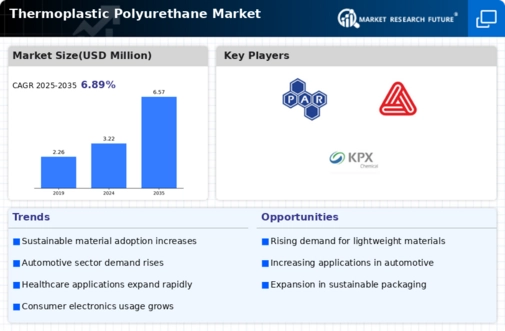Top Industry Leaders in the Thermoplastic Polyurethane Market

Thermoplastic polyurethane (TPU), a versatile material famed for its resilience, elasticity, and adaptability, finds itself at the heart of a thriving market. With applications spanning from footwear and automotive interiors to medical devices and construction. Such promising figures have lured a diverse range of players, creating a dynamic and fiercely competitive landscape.
Strategies Adopted in the TPU Market:
-
Product Diversification: Leading players like BASF SE, Covestro AG, and The Lubrizol Corporation offer a plethora of TPU variants with customized properties catering to specific end-use industries. Eco-friendly and bio-based alternatives are gaining traction, driven by sustainability concerns. -
Vertical Integration: Backwards integration to secure raw materials like isocyanates and polyols is a growing trend, ensuring supply chain stability and cost-effectiveness. Companies like Huntsman Corporation and Tosoh Corporation are actively pursuing this strategy. -
Regional Expansion: Established players are setting up new production facilities in emerging markets like China, India, and Southeast Asia, capitalizing on the booming demand from these regions. Regional players like Wanhua Chemical Group and Huafon Group are also vying for dominance in their respective domains. -
Focus on R&D and Innovation: Continuous research into new TPU formulations with enhanced properties for specific applications like high-performance sporting goods or medical implants is crucial for differentiation and market leadership. Partnerships with universities and research institutions are fostering innovation. -
Strategic Collaborations and Acquisitions: Mergers and acquisitions are shaping the market landscape, with companies seeking to expand their offerings, access new technologies, and enhance their geographical reach.
Factors Influencing Market Share:
-
Production Capacity and Cost-Competitiveness: Ability to produce high-quality TPU at competitive prices gives a significant edge, especially in cost-sensitive segments like footwear and apparel. -
Quality and Regulatory Compliance: Meeting stringent quality standards, adhering to regional regulations, and obtaining relevant certifications for specific applications (e.g., medical use) are essential for securing trust and market access. -
Technical Expertise and Customer Service: Providing comprehensive technical support, application know-how, and customized solutions for specific client needs builds long-term relationships and fosters loyalty. -
Distribution Network and Logistics: A robust and efficient global or regional distribution network ensures timely delivery, reduces supply chain disruptions, and improves customer satisfaction. -
Brand Reputation and Marketing: A strong brand reputation built on quality, innovation, and reliability goes a long way in a competitive market. Effective marketing strategies are crucial for raising brand awareness and attracting new customers.
Key Players:
- PAR Group
- BASF SE
- The Lubrizol Corporation
- American Polyfilm Inc
- 3M
- Avery Dennison
- Bayer Material Science
- Huntsman Corporation
- KPX Chemical
- Permali Gloucester Limited
Recent Developments :
In 2024, The University of California San Diego (UC San Diego) and Algenesis Corporation, a forward-thinking material science firm founded on UC San Diego's inventive ethos, are pleased to announce the publishing of a significant scientific study in the fight against microplastic pollution.
May 2020 saw BASF SE start building electronics plastics compounding and Thermoplastic Polyurethane plants in Zhanjiang, China, as part of its advanced chemical manufacturing site (‘Verbund’). These facilities will be located provincially and regionally to Southern China’s market and global customers, thereby promoting proximity and productivity.
August 2022: BASF SE announced the launch of their Thermoplastic Polyurethane Paint Protection Film from RODIM.
September 2021: KPX Chemical announced a strategic joint venture with Huntsman in Korea to provide customized polyurethane systems solutions.

